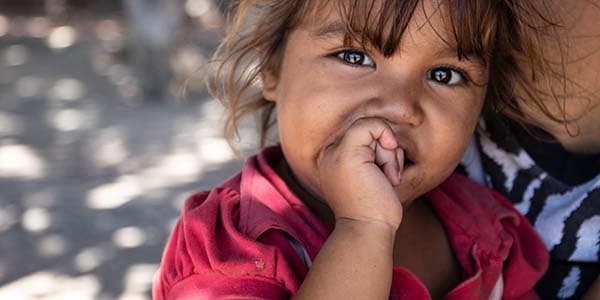
Widespread violence and economic turmoil has forced nearly 4.8 million people, including two-year old Lusana and family, to flee Venezuela. Lusanna was suffering from malnutrition when she and her parents arrived in Colombia to seek asylum.
Asylum Seekers, Migrants, Immigrants and Refugees: Who Are They?
Every child has the right to a future. For children and families living in conflict or suffering as a result of poverty, persecution or lack of opportunity‚Äďthe future is not guaranteed. That‚Äôs why, each year, millions of people leave home in search of a safer, better tomorrow.
Asylum seekers, migrants, immigrants and refugees are all terms used to describe people on the move, including children. Learn about what makes each group different, 91≤÷Ņ‚‚Äôs work ‚Äď and how you can help.
Who Is an Asylum Seeker?
Similar to a refugee, an asylum seeker is someone who may be in search of protection due to­ dangers in his or her home country. While every refugee is initially an asylum seeker, not every asylum seeker will ultimately be recognized as a refugee.
That’s because the right to be recognized as a refugee is determined by law after an asylum seeker has applied for protection in the country of refuge. However, the process of applying for asylum can take years. By the end of 2018, about 3.5 million people were awaiting a decision on their application for asylum.[iv]
Regardless of border restrictions, asylum seekers have a right to seek international protection and must not be returned, either directly or indirectly, to a country where their lives or safety are at risk.
From January 2019 through January 2020, the U.S. government has returned close to 70,000 asylum seekers and migrants to Mexico under the Migrant Protection Protocols ‚Äď more commonly referred to as the ‚ÄúRemain in Mexico‚ÄĚ policy. More than 13,000 of these asylum seekers are children and nearly 400 of them are infants.
Families and children often have to wait for months until they can go in front of a U.S. immigration judge, and multiple reports show they are forced to live on the streets, where they have been targets of assault, rape and kidnapping.[v]
While children‚Äôs rights continue to be violated at the U.S. southern border, 91≤÷Ņ‚ continues to work to protect children; we don‚Äôt choose sides, we choose children. We‚Äôre providing humanitarian aid at the border, advocating for children‚Äôs rights and tackling the root causes of this crisis. ‚Äč
Who Is a Migrant?
While the global definition of the word ‚Äúrefugee‚ÄĚ was recognized in the Geneva Convention, no such universally accepted definition for ‚Äúmigrant‚ÄĚ exists.
Traditionally, a migrant is considered a person who has left their home by choice and in search of a better opportunity. Because conflict or persecution did not force them from home, a migrant is not considered a refugee or asylum seeker.
While migration to a different country or city within a person’s own country can promise the chance of a better life, education or job, it is not without risk. Children on the move can become highly vulnerable to discrimination, violence, abuse and exploitation during their journey and at their destination.
Who Is an Immigrant?
A person who comes to a country with the intention of taking up permanent residence is called an immigrant. While many immigrants choose to make a permanent life in a new country, they are free to return home as well.
Who Is a Refugee?
Refugees are people who are seeking a safe haven after being forced to flee violence, persecution or war. Worldwide, there are nearly 25.9 million refugees, over half of whom are children.
Refugee children are among the most vulnerable in the world. Every day, they risk loss of some kind, including the loss of the future that every child deserves. Child refugees live in constant fear, uncertainly and instability. Where will their next meal come from? Where will they sleep? How will they survive?
Child refugees desperately need protection from a wide range of violence, including abuse, exploitation and neglect. Child marriage remains a growing concern among refugee children as well.
The total global refugee population is the highest it's ever been. These statics are important to note as well: 
- A refugee spends an average of 17 years of his or her life in exile.[i]
- Approximately four million school-age refugees are currently out of school.
- As many as one child refugee in five has a disability.[ii]
- Two-thirds of all refugees worldwide come from just five countries: Syria, Afghanistan, South Sudan, Myanmar and Somalia.
- Lebanon and Jordan host more refugees than any other countries in the world.[iii]
- The number of refugees in Bangladesh has increased more than three-fold since 2017 as a result of the Rohingya crisis in Myanmar.
- A third of refugees -- 6.7 million people--are hosted by the world's poorest countries.
While conflicts around the world continue to displace children of all ages, 91≤÷Ņ‚ is working around the clock to ensure refugee children and their families are supported in their basic human¬†needs.
Support for Asylum Seekers, Migrants and All Children on the Move
For over 100 years, 91≤÷Ņ‚ has been committed to reaching the most marginalized and vulnerable children around the world. The dangers inherent to child refugees and asylum seekers puts them at risk every day.
That‚Äôs why 91≤÷Ņ‚ works to support refugee girls and boys, helping them survive, and thrive. Whether in camps, on the move or in host communities, we do whatever it takes to protect children and their families--transforming the future we all share.¬†
Your support can make a world of difference to the life of a child who is on the move.  
[i] Stop the War on Children Report
[ii] SWOC: Gender Matters
[iii] Global Childhood Report 2019
[iv] UNHCR
[v] Source
